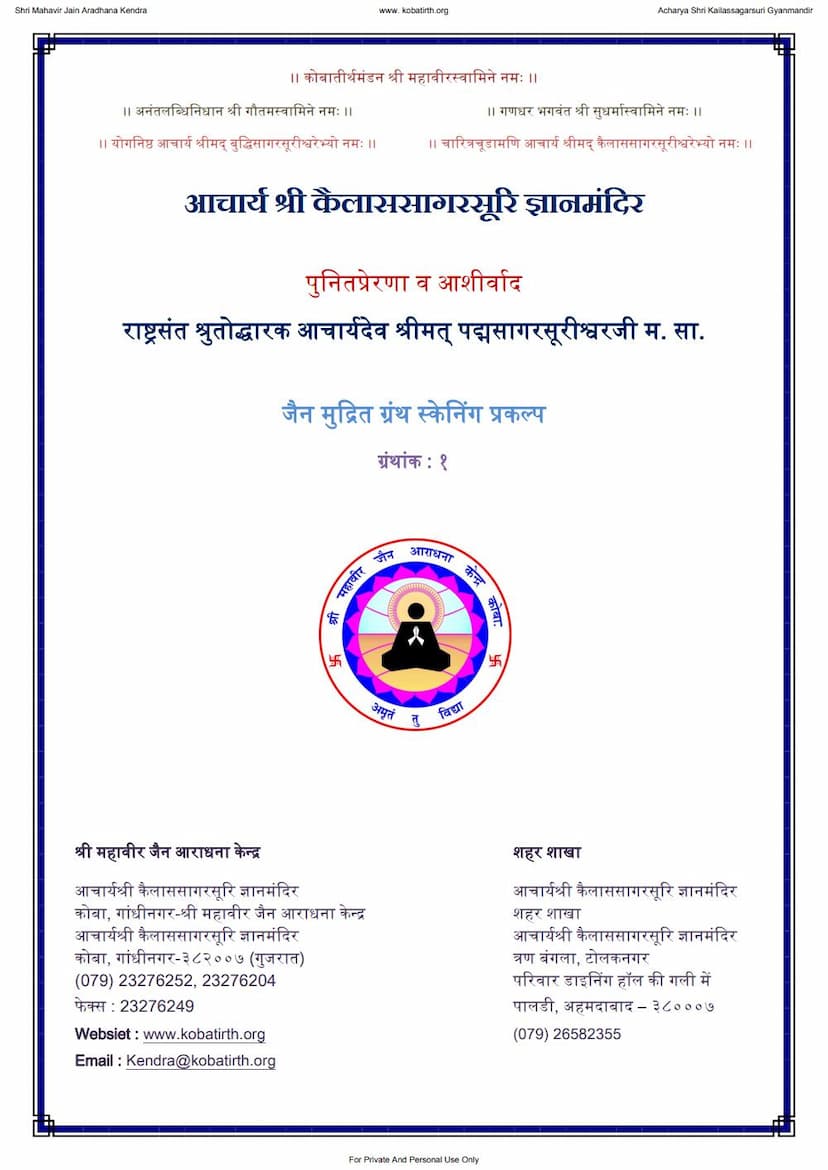Bharat Bhaishajya Ratnakar Part 04
Added to library: September 1, 2025

Summary
Based on the provided text, here's a comprehensive summary of the Jain text "Bharat Bhaishajya Ratnakar Part 04":
Book Title: Bharat Bhaishajya Ratnakar Part 04 Author(s): Nagindas Chaganlal Shah, Gopinath Gupt, Nivaranchandra Bhattacharya Publisher: Unza Ayurvedik Pharmacy
This volume, the fourth part of the Bharat Bhaishajya Ratnakar, is a significant Jain text dedicated to the principles and practices of Ayurveda. It meticulously details various medicinal preparations, focusing on their composition, therapeutic properties, and applications for a wide array of ailments.
The text is structured systematically, covering different categories of Ayurvedic remedies. The primary focus of this volume appears to be on Kashaya (decoctions), Churna (powders), Gutika (pills/tablets), Guggulu (formulations with Guggulu), Avleha (jams/pastes), Ghrita (medicated ghees), Taila (medicated oils), Asava and Arishta (fermented medicinal preparations), Lepa (pastes/ointments), Anjana (collyria), Nasya (nasal drops), Rasa (mercurial/mineral preparations), Kalpa (special preparations), and Mishra (mixed formulations).
Key Features and Content:
- Extensive Pharmacopoeia: The book functions as a comprehensive Ayurvedic pharmacopoeia, listing numerous formulations with specific ingredients and their preparation methods. The sheer volume of recipes for each category (e.g., multiple types of "Manjishthadi Kashaya" or "Marichadi Churna") highlights the depth of Ayurvedic knowledge preserved in this text.
- Detailed Ingredient Lists: Each formulation is described with a precise list of medicinal herbs and minerals, often specifying the parts of the plant used (root, leaf, bark, etc.) and their proportions.
- Therapeutic Indications: The text clearly outlines the diseases and conditions for which each preparation is recommended. This ranges from common ailments to more severe and chronic conditions, including:
- Skin diseases (Kushtha, Sidhma, Vitiligo, Psoriasis, etc.)
- Digestive issues (Agni-mandya, Grahaṇī, Atisāra, Gulma)
- Respiratory problems (Kasa, Shwasa, Hikka)
- Neurological and Musculoskeletal disorders (Vata vyadhi, Pakshaghata, Gridhrasi, Uru-stambha, Shirah shula)
- Fever (Jwara) of various types.
- Urinary and Reproductive issues (Mutrakṛcchra, Prameha, Yonidosha, Vandhyatva)
- Poisoning (Visa)
- General debility (Shukra-kshaya) and rejuvenation (Rasayana).
- Mental and Nervous disorders (Unmada, Apasmara)
- Ocular and ENT ailments (Netra roga, Karna roga, Nasa roga).
- Preparation Methods: The text provides detailed instructions on how to prepare these medicines, including processes like decoction (Kwatha), powdering (Churna), fermentation (Asava/Arishta), medicated ghees (Ghrita), and preparations involving minerals and metals (Rasa).
- Alphabetical Organization: The content within the major categories appears to be organized alphabetically, starting with 'Ma' (म) and progressing through the Sanskrit alphabet (e.g., Manjishthadi, Madana, Madhuka, Maricha, Musta, etc.).
- Ayurvedic Philosophy: While not explicitly detailed in the provided excerpt, the underlying philosophy of Ayurveda, emphasizing the balance of Doshas (Vata, Pitta, Kapha) and the use of natural ingredients, is evident in the selection and application of these remedies.
- Jain Context: Although the text focuses on Ayurveda, its publication under the auspices of Jain institutions (Shri Mahavir Jain Aradhana Kendra) suggests a historical or cultural connection to Jainism, possibly indicating its use or preservation within Jain communities. The text itself, as presented, is primarily an Ayurvedic treatise.
Specific Categories and Examples:
- Kashaya (Decoctions): A significant portion of the volume details various decoctions, with "Manjishthadi Kashaya" appearing multiple times with different compositions, indicating its importance in treating skin conditions and related disorders. Other Kashayas are described for fever, gout (Vata rakta), and general detoxification.
- Churna (Powders): Various powders are listed, such as "Manjishthadi Churna" for coughs and "Madana Prakasha Churna" for strengthening the body and improving virility.
- Gutika (Pills): Formulations like "Mandura Gutika" (from Rasa section), "Mandura Vataka," and "Madan Manjari Gutika" are mentioned, highlighting the preparation of medicinal pills.
- Rasa (Mercurial/Mineral Preparations): The "Rasa" section is extensive, featuring complex preparations involving mercury, sulfur, various metals, and minerals, often for severe conditions like fevers, skin diseases, and strength enhancement. Examples include "Makara Dhwaja Rasa," "Mahajwarankusha Rasa," and "Mahalaxmi Vilasa Rasa."
- Ghrita (Medicated Ghee): Numerous medicated ghees are described, like "Manjishthadi Ghrita" for eye diseases and "Mahakalyana Ghrita" for a wide range of ailments including insanity and neurological issues.
- Tails (Medicated Oils): Various oils are detailed for external application or nasal administration (Nasya), with "Manjishthadi Taila" and "Mahatiktaka Ghrita" (though listed under Ghrita, its preparation might involve oil) appearing for skin and systemic diseases.
- Leptas (Pastes): Pastes for external application, such as those for wound healing and skin disorders, are also included.
In essence, "Bharat Bhaishajya Ratnakar Part 04" is a vital repository of Ayurvedic knowledge, likely used by practitioners for preparing and administering a wide spectrum of remedies. Its detailed, ingredient-specific, and ailment-focused approach makes it a valuable resource for understanding traditional Indian medicine. The introductory pages also show a dedication and reverence to Jain spiritual leaders, indicating the context of its preservation and dissemination.